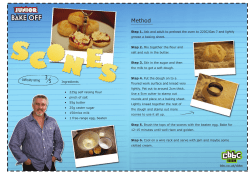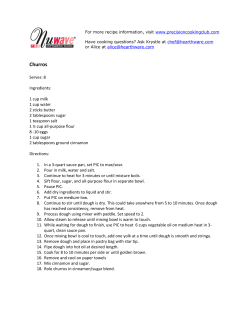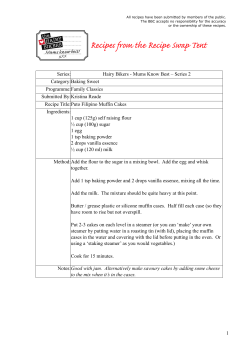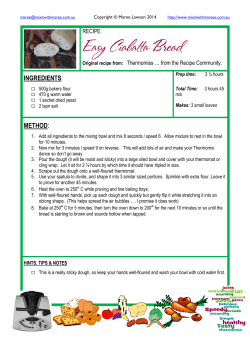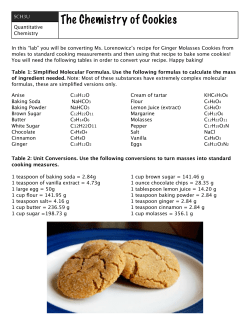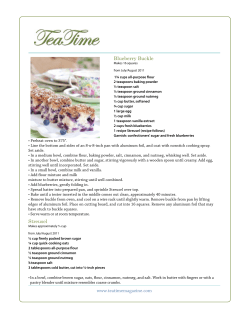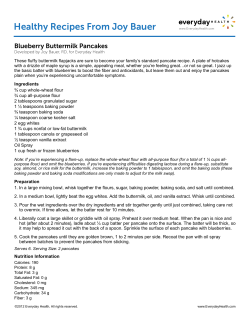
Vegan Baking! $2.50 www.hamiltonfreeskool.org
$2.50 (suggested donation) A pretty simple introduction to... Vegan Baking! Based on recipes used in Vegan Baking class www.hamiltonfreeskool.org summer 2009. Includes ten easy recipes, detailed instructions for beginner bakers, information about baking and vegan baking including ingredients recommendations, and a list of awesome vegan baking resources. www.hamiltonfreeskool.org Contents: This little cook zine is a compilation of the recipes used in the Summer 2009 semester of Hamilton Freeskool's Vegan Baking class which was facilitated by Amy (me) and ran weekly at Jamesville Community Centre. The recipes included are very simple, intended for vegan baking beginners and a resource from which to expand your vegan baking repertoire. They are also good stand-by recipes for more advanced bakers. Big thanks to everyone who came out to class this summer and shared their knowledge and curiosity! Next Freeskool summer semester (and the next zine) will get into fancier recipes... stay tuned! If you have any questions about this zine, the recipes or vegan baking in general, you can contact me at amyvegan@riseup.net Questions about Hamilton Freeskool can be directed to hamiltonfreeskool@gmail.com or check out the Freeskool website: www.hamiltonfreeskool.org Class Introduction The Basic Chemistry of Baking and Common Ingredients Chocolate Chip Cookies Pumpkin Pie with Spelt Crust Brownies Blueberry Muffins Cinnamon Buns (with optional Cream Cheese Frosting) Pizza Dough Whole Wheat Bread Pumpkin Spice Biscotti Chocolate Cupcakes with Whipped Chocolate Topping References and Further Information Class Introduction May 25, 2009. The purpose of this course is to help both baking beginners and veteran bakers learn how to make great tasting vegan baked goods. While we're baking as a group, we'll talk a bit about how the baking process works. Advantages of baking vegan include lowering your impact on the environment, since animal agriculture is extremely ecointensive, that vegan baked goods are mostly lowerfat and cholesterolfree, and perhaps best of all, you can eat cookie dough and cake batter worryfree since there's no raw eggs involved (which also means it safer for baking with kids)! You'll see that you can make vegan versions of most conventional baking recipes, that taste just as good or better than the original. The Basic Chemistry of Baking and Common Ingredients Flour Fat Provides the bulk of the baked good. Wheat flour is most often used in baking, however flours made from other grains are also frequently used (rye, spelt, quinoa and rice). Bread flour or hard flour is a higher protein wheat flour (about 1214% protein) and is used for bread baking for best gluten development, while cake flour or soft flour has a lower protein content (around 9%). Allpurpose flour can generally be used effectively for either application. Its protein content falls somewhere in the middle of the previous two. (Protein content varies depending on the source of the flour and where it is milled). Whole wheat flour can be substituted in most recipes for some or all of the white flour, make sure to use whole wheat pastry flour for cakes, pies, cookies, etc. and whole wheat bread flour for breads. Note that whole wheat flour will change the texture and density of the finished product, especially if the product is 100% whole wheat. In vegan baking, the fats used are vegetable oils or vegetable oil based shortening or margarine. Some recipes might also contain coconut or other nut oils. In addition to providing flavour, fats in baking keep the flour from forming an overly extensive network of gluten, giving the baked good a lighter texture.* Sugar or Many vegans prefer to use organic sweeteners that are Sweetener completely free of animal byproducts, which is sometimes not the case with conventional white and brown sugars. Sugar alternatives frequently used include turbinado sugar, sucanat and fructose.* Liquid sweeteners might also be used in vegan baking, such as maple syrup, molasses, concentrated fruit juice, and brown rice syrup. Sugar provides flavour and helps form the golden crust of the baked product. Baking Soda When sodium bicarbonate (baking soda) heats up, it causes a chemical reaction which creates CO2. The CO2 gas leavens and makes the "bubbles" in baked goods. Baking Powder Mixture of baking soda and an acid to help neutralise the base, which minimizes the “soapy” taste and also produces more CO2. Look for aluminiumfree baking powder. Salt Helps slow down the creation of CO2. Sea salt preferred. Egg (or replacer) Eggs have several functions in baking, including retaining gas bubbles, leavening and binding. Common egg replacers used in vegan baking include commercial egg replacers, ground flaxseed, corn starch, applesauce, and silken tofu. In many vegan recipes, the exact ingredients required for the necessary chemical reactions will be listed, therefore there will be no need for you to choose which type of egg replacer to use.** Yeast Yeast feeds on starch and sugars, releasing CO2 alcohol and sugar. The CO2 bubbles give the dough a light, airy texture. • * Vegan fat and sugar products available at local retailers that work well in baking: for fats, look for Earth Balance Buttery Spread and shortenings, and for sugars, a brand called Wholesome Sweeteners makes several different kinds of organic, fairtrade vegan sugars that reproduce the effects of conventional white and brown sugar in baking. • ** Certain egg replacers work better in particular types of recipes than others. For example, applesauce works in muffins and some cakes, but not very well in cookies. Good vegan recipes do not call for “egg replacer” but instead tell you exactly which ingredients to use. A Note on the Recipes to Follow Almost all of these recipes were used in the Hamilton Freeskool vegan baking class this summer. They were chosen for both their simplicity and yumminess. If you are totally new to baking, the chocolate chip cookie recipe contains ingredients that will be easy to locate and the directions are very detailed. Even if you don't use that recipe first, if your baking skills are a bit rusty, there are a few pointers in there to help so you might want to check it out. On the other hand, the pumpkin spice biscotti is really a gourmet recipe in disguise. Easy to make, but it is delicious and pretty. Chocolate Chip Cookies (From Week 1: May 25, 2009) This is a very basic chocolate chip recipe with simple ingredients. Even though it's a simple recipe, pay close attention to the preparation instructions. These will help you with recipes in the future. Supplies required will be underlined in the recipe directions. Directions: 1. Preheat oven to 350 degrees Fahrenheit. (Always use an internal thermometer in case your oven temperature gauge is incorrect.) Line two large cookie sheets with parchment paper (optional if using nonstick cookie pans). 2. In a medium bowl, use a sieve to sift together flour, salt and baking soda. Stir briefly with a wooden spoon to combine. 3. In a small bowl, stir together corn starch and water. (This is considered the egg replacer in this recipe). 4. In a large bowl, cream together margarine, sugars, vanilla and the corn starch and water mixture until frothy. 5. Gently mix dry ingredients to wet ingredients until combined. Fold in chocolate chips. 6. Drop by rounded tablespoonfuls 2 inches apart onto cookie sheet. (A small ice cream scoop, available at restaurant supply stores, speeds up this process). 7. Bake for 9 to 11 minutes. Bottoms of cookies will be golden when they are finished. 8. Allow to cool on the pan for a minute or two, and then transfer to a cooling rack. Yield: 2 dozen cookies Pumpkin Pie with Spelt Crust Ingredients: 2 ¾ cups allpurpose flour 1 teaspoon sea salt 1 teaspoon baking soda 1 cup margarine ¾ cup brown sugar ¾ cup white sugar 1 teaspoon vanilla extract 2 tablespoons of corn starch ¼ cup water 1 ½ cups semisweet chocolate chips (From Week 8: July 27, 2009) Spelt Pastry Ingredients: 1 ¼ cup + 1 teaspoon white spelt flour 2 tablespoons brown sugar or turbinado ¼ teaspoon salt 3 tablespoons vegetable oil 2 tablespoons + 2 teaspoons cold water Directions: Stir together dry ingredients in large bowl. Drizzle in vegetable oil and continue stirring, ingredients should begin to clump together. Slowly add water, stirring, until the mixture is moist enough that you can form a ball with the dough. Roll into a ball. At this point, you may wrap the dough in plastic wrap and refrigerate to chill if you prefer working with cold pastry, or continue. On a lightly floured work surface, press down dough with your hands slightly, then begin rolling into circle to fit pie plate. Transfer dough to pie plate and fill. Note: omit sugar for unsweetened crust for pot pies, etc. Brownies (From Week 2: June 1, 2009) This is truly a Freeskool Vegan Baking creation. Based on a recipe from one of my favourite cookbooks, we made numerous modifications in class (on purpose, and accidentally) which I then altered further the next morning to come up with this extremely rich, chewy brownie recipe. I have tried a lot of vegan brownie recipes and they were total failures, so I was thrilled when these turned out so well. Ingredients: Pumpkin Pie Filling Ingredients: 1 1/4 pounds soft tofu (try extrafirm “silken” tofu for a creamier texture) 1 16ounce can pumpkin purée 3/4 cup maple syrup 3/4 cup sugar 1/3 cup unbleached allpurpose flour (white spelt OK) 1 tablespoon ground cinnamon 1 teaspoon ground ginger 1 teaspoon ground nutmeg Directions: Preheat oven to 375 degrees Fahrenheit. Purée all ingredients in a food processor. Pour filling into unbaked pie crust and bake for 45 minutes. Allow to cool completely before serving. Refrigerate. Yield: 1 yummy pie (810 slices). 1 scant cup margarine, melted (“scant” basically means “just a bit less than”) 1 2/3 cups white sugar 2 tablespoon water 2 “egg replacers” (use EnerG or Pane Riso Foods egg replacer according to directions on box) 2 teaspoons vanilla extract 1 scant cup cocoa powder 1 1/3 cup flour ½ teaspoon baking powder ¼ teaspoon salt Directions: 1. Preheat oven to 350 degrees Fahrenheit. 2. Stir margarine, sugar and water together in a mediumsized bowl, then add the egg replacer and vanilla extract. 3. Sift together dry ingredients in a separate bowl. 4. Slowly mix wet ingredients into dry using a fork, continue stirring until thoroughly combined and there are no clumps left. 5. Spread batter in an ungreased 8 x 8 inch square baking pan and bake for 30 minutes. 6. Remove from oven and insert a toothpick into centre of pan. It should come out fairly clean. Place pan on cooling rack and allow to cool before serving. Yield: a dozen squares or so Blueberry Muffins Cinnamon Buns with Cream Cheese Frosting (From Week 3: June 15, 2009) (From Week 6: July 6, 2009) Ingredients: Cinnamon Buns 1 cup soy milk (or other nondairy milk) ½ cup margarine ¼ cup applesauce 1 teaspoon vanilla extract 2 cups flour (try 1 cup allpurpose, 1 cup whole wheat) 1 scant cup sugar + 2 tablespoons sugar 2 tablespoons baking powder ½ teaspoons salt 1 ½ cups blueberries, fresh or frozen Ingredients: Directions: 1. Preheat oven to 350 degrees Fahrenheit. Spray a muffin tin with nonstick spray or line with muffin liners. 2. In a large bowl, cream margarine. Cream in soy milk, applesauce and vanilla extract. 3. In a medium bowl, sift together flour, sugar, baking powder and salt. Stir dry ingredients into wet with a fork until you have a smooth batter. Fold in blueberries. (If using frozen, fold in only a few motions as the colour will otherwise bleed into the batter.) 4. Spoon batter into muffin tins until each is almost full. Sprinkle tops with sugar (optional). 5. Bake for 35 minutes until tops are firm. Remove and cool on a rack. Yield: 1 dozen large muffins Notes: This recipe uses applesauce as an egg replacer. The amount of margarine and applesauce can be switched to make a lowerfat muffin, however this will result in a less crispy top. Using whole wheat flour in the recipe will make the muffins denser. Bonus! The blueberries in this recipe can be replaced with chocolate chips. Dough: 3 cups allpurpose flour 1 cup warm water (about 110 degrees Fahrenheit) 2 tablespoons sunflower oil or melted margarine + additional for oiling bowl and pans 2 tablespoons sugar 3 teaspoons active dry yeast ½ teaspoon salt ¼ teaspoon nutmeg Filling: 1 cup brown sugar ½ cup vegan margarine ½ cup raisins, nuts or frozen fruit (optional) ¼ cup maple syrup OR brown rice syrup 3 tablespoons cinnamon 2 teaspoons vanilla extract Directions: 1. Combine the water, yeast and sugar in a large bowl and wait a few minutes for the yeast to bubble. While waiting, stir together flour, salt and nutmeg in a separate bowl. Once the yeast bubbles, stir in the oil or melted margarine, then add the flour mixture gradually stirring with a wooden spoon. Once the dough starts coming together, remove to floured work surface for kneading. 2. Flour your hands to keep the dough from sticking. Knead for about five minutes, until the dough is smooth and elastic. Transfer the dough to a lightly oiled 2quart (glass or plastic) bowl. Cover the bowl with plastic wrap or a kitchen towel, and let the dough rest in a warm area until it has doubled in size, about 1 hour. 3. While the dough is rising, prepare your filling and baking pan. Melt margarine and stir in brown sugar, maple syrup, cinnamon and vanilla extract. Line a 9x11 cake pan with parchment paper, and lightly oil or spray the edges. 4. When the dough has risen, place it on a lightly floured surface, divide it into two parts and roll them into balls. Set one aside and recover with towel to prevent drying. Roll the first ball into a 9x13 inch rectangle, spread with filling leaving a ½ inch gap at the top, sprinkle in raisins, nuts and/or fruit. Using your fingers or a pastry brush, moisten the ½ inch strip with water. Carefully begin rolling the dough up towards the top, until it is rolled completely. Pinch the seam together, and flip the roll seamside down onto a cutting board. Cut into 6 equal pieces using bench knife or sharp serrated bread knife. Carefully move each piece to the prepared baking pan. Repeat with second piece of dough. When all the buns are in the pan, cover with the towel and allow to rise for about 30 minutes. 5. Preheat the oven to 350 degrees Fahrenheit. After the second rise, bake the cinnamon buns for 1520 minutes. Remove to cooling rack and serve after allowing to cool for a few minutes. Yield: 1 dozen cinnamon buns Optional: Vegan Cream Cheese Frosting Ingredients: ½ cup vegan cream cheese (Tofutti, NOT Yoso, blech) 2 cups confectioner's sugar 1 teaspoon vanilla extract Directions: Use a hand mixer to cream Tofutti with vanilla extract, adding in ½ cup of confectioner's sugar at a time. Once smooth, transfer to air tight container and store in refrigerator. This tends to be runny, so not good for cake decorating. Pizza Dough (From Week 5: June 29, 2009) Ingredients: 1 cup warm water (about 110 degrees Fahrenheit) 2 ¼ teaspoons active dry yeast 2 ½ to 3 cups allpurpose flour 2 tablespoons olive oil ½ teaspoon salt Directions: 1. Combine the water, yeast and 1 ½ cups of the flour in a large bowl. Mix well. 2. Add the oil, salt, and remaining flour. With a large wooden spoon or your hands, mix the ingredients together until the dough holds its shape. You may need a bit less flour, so add the last cup gradually. 3. Place the dough on a lightly floured surface and knead until smooth and elastic, about 5 minutes. If the dough becomes sticky, sprinkle a bit more flour over it. 4. Transfer the dough to a lightly oiled 2quart (glass or plastic) bowl. Cover the bowl with plastic wrap or a kitchen towel, and let the dough rest until it has doubled in size, about 1 hour. 5. When the dough has risen, place it on a lightly floured surface, divide it into two or more parts and roll them into balls (see note). Cover them with a towel and let rest for 15 minutes. Preheat the oven to 400 degrees Fahrenheit. 6. Using olive oil, generously grease a cookie sheet or pizza pan. Roll the dough out flat in the shape of the pan you are using. Once it is approximately the right size, move it to the sheet. Continue rolling or pressing it into the pan, if necessary. (Continued on next page...) 7. Top the pizza with desired toppings and bake for 20 to 30 minutes, depending on how thickly it is rolled. Avoid burning the bottom by placing it on the middle rack and checking its underside after 20 minutes. See suggestions below for toppings. Yield: 2 large crusts Awesome Vegan Pizza Toppings White pizza: spread pizza dough generously with olive oil and minced garlic, top with spinach and roasted red peppers. Veggie Pizza: spread pizza dough generously with pizza sauce from a jar (or home made!), sliced mushrooms, sliced green peppers, sliced tomatoes, sliced olives, and other typical pizza veggies. Red Hot Pizza: spread pizza dough generously with pizza sauce from a jar, and top with sliced hot peppers. Irony Pizza: spread pizza dough with pizza sauce, top with sliced pepperoni by Yves, and cover with GOOD grated vegan cheese such as Earth Island Vegan Gourmet Mozzarella (putting the fake pepperoni under the cheese keeps it from drying out). Note on how to shape a ball of dough or “boule” – We learned in class how to shape dough, which is really the best way to learn (in person). I hope these written instructions suffice. Take each piece of dough and form it into a tight ball. You can do this by pulling up the edges of the dough into the centre, then flipping it over onto the the creases. Cup the ball in your hands, and pull it towards yourself while turning counterclockwise at the same time. This will tighten the dough and help seal the bottom. Set aside on floured surface to rest. (See next page for how to shape it for a loaf pan.) Whole Wheat Bread (From Week 7: July 20, 2009) Ingredients: 3 cups white flour 2 ¼ cups whole wheat flour 1 ½ cups warm water (about 110 degrees Fahrenheit) 1/8 cup sugar 1 tablespoons active dry yeast 1 tablespoon oil, olive or sunflower ¾ teaspoon salt Directions: 1. In a large bowl, stir together water, sugar and yeast. Allow to sit for several minutes until yeast bubbles. Then stir in oil and salt. 2. Add the white flour, because it has the most gluten, and stir with wooden spoon until clumps are gone. Stir in whole wheat flour. 3. Remove to floured surface and knead for about five minutes until texture is even and feels elastic. 4. Place dough in a large (glass or plastic) bowl and cover with a clean, wet towel. Allow to rise in warm area until it doubles in size, about an hour. 5. Remove from bowl and cut in half. Shape into loaves (see notes). Place in oiled loaf pans and allow to rise until doubled in size again. 6. Preheat oven to 350 degrees Fahrenheit. Bake risen loaves for about 45 minutes. Yield: 2 loaves Turn your ball (see note on last page) into a loaf – Press ball into a loose oval shape about the length of your pan. Fold edges in about an inch or two to create a rectangle, then fold in half lengthwise and pinch together at at the seam. Place seam side down into loaf pan and allow to rise. Pumpkin Spice Biscotti Chocolate Cupcakes with Whipped Chocolate Topping (From Week 4: June 22, 2009) [Bonus Recipe!] Ingredients: 2 1/3 cups unbleached allpurpose flour 2/3 cup sugar 2 teaspoon baking powder 2 teaspoon cinnamon ½ teaspoon baking soda ½ teaspoon ginger ½ teaspoon nutmeg ¼ teaspoon salt ½ cup pumpkin seeds 2/3 cup pumpkin, canned ½ cup maple syrup 1/3 cup water 1/3 cup canola oil (or sunflower oil) 1 teaspoon vanilla 2 tablespoons sugar, for garnish Directions: 1. Preheat oven to 350 degrees Fahrenheit. 2. In a large bowl, sift together the dry ingredients. In another bowl, combine the pumpkin, maple syrup, water, vanilla and oil. Add the wet mixture to the dry mixture, and mix until well combined, making a thick dough. 3. Divide the dough in half and shape into logs (roughly 1 inch thick, 4 inches wide and 89 inches long. 4. Place on a baking sheet lined with parchment paper (make sure there is space between them), and bake for 3537 minutes. Remove from oven to let cool, about 10 minutes. 5. Using a serrated knife, cut biscotti into strips on a slight diagonal, about 1 ½ inches thick. Sprinkle with the extra sugar nd bake for another 15 minutes. Remove from oven and carefully transfer to cooling rack. Yield: 12 pieces biscotti The two cake recipes we used in class were basically direct ripoffs from the fantastic vegan cookbook Vegan Cupcakes Take Over The World. So rather than risking copyright infringement, I'm sticking in this equally awesome chocolate cake recipe that is rumoured to be from the Great Depression when eggs and milk weren't as commonly available. Chocolate Cupcakes Ingredients: 1 ½ cups allpurpose flour 1 cup sugar 3 tablespoons cocoa powder ½ teaspoon salt 1 cup cold water 1/3 cup vegetable oil 1 tablespoon white vinegar 1 teaspoon vanilla extract Directions: 1. Preheat oven to 350 degrees Fahrenheit. Line muffin tin with medium to large sized liners. 2. Sift and combine flour, sugar, cocoa, baking soda and salt in a mediumsize bowl. In a smaller bowl, combine water, oil, vinegar and vanilla. Make a depression in the dry mix and stir in the wet. Beat until smooth. 3. Spoon batter into muffin tins to ¾ full and bake for 3040 minutes (until toothpick comes out clean). Allow to cool completely before frosting. Yield: 12 cupcakes Chocolate whipped topping recipe on next page... Whipped Chocolate Topping Ingredients: 1 (12.3 oz.) package extrafirm silken tofu (MoriNu brand) ¼ cup plain soy milk 1 teaspoon vanilla extract 1 (12 oz.) package semisweet chocolate chips Purée all ingredients except chocolate chips in blender or food processor until smooth. Use a double boiler (or a small saucepan set over a larger pot) to melt chocolate chips, stirring frequently as it melts. Alternatively, you can carefully use the microwave—place all chips in an uncovered microwavesafe container, cook on high for about 1 minute then stir, then microwave for an additional 30 seconds to 1 minute (depending on strength of microwave). Stir well after removing, the heat from the melted chips should melt any that are not completely melted. Scrape into food processor and purée until well mixed. Pulse several times to add air. Transfer to air tight container and refrigerate for an hour before use. Pipe onto cooled cupcakes. Yield: enough for cupcakes and lots leftover to eat , yum! Awesome Vegan Baking Resources Websites: The Post Punk Kitchen [http://www.theppk.com/veganbaking.html] The Vegan Chef [http://www.theveganchef.com] VegCooking.com (PETA) [http://www.vegcooking.com] A Vegan Ice Cream Paradise [http://veganicecream.blogspot.com] Amy Vegan's Recipes [http://www.amyvegan.ca] Baking Pan Sizes [http://www.joyofbaking.com/PanSizes.html] VegWeb [http://www.vegweb.com] Dreena's Vegan Recipes [http://viveleveganrecipes.blogspot.com] Sources slash Recommended Books and Zines: Hot Damn & Hell Yeah (zine) The “Real” Anarchist Cookbook (zine) Vegan Cupcakes Take Over the World Vegan Vittles Foods That Don't Bite Back The Farm Vegetarian Cookbook Spelt Healthy Frugal Vegan's Harvest and Holiday Survival Guide (zine) (Some of these zines can be ordered from Microcosm Publishing www.microcosmpublishing.com)
© Copyright 2024


